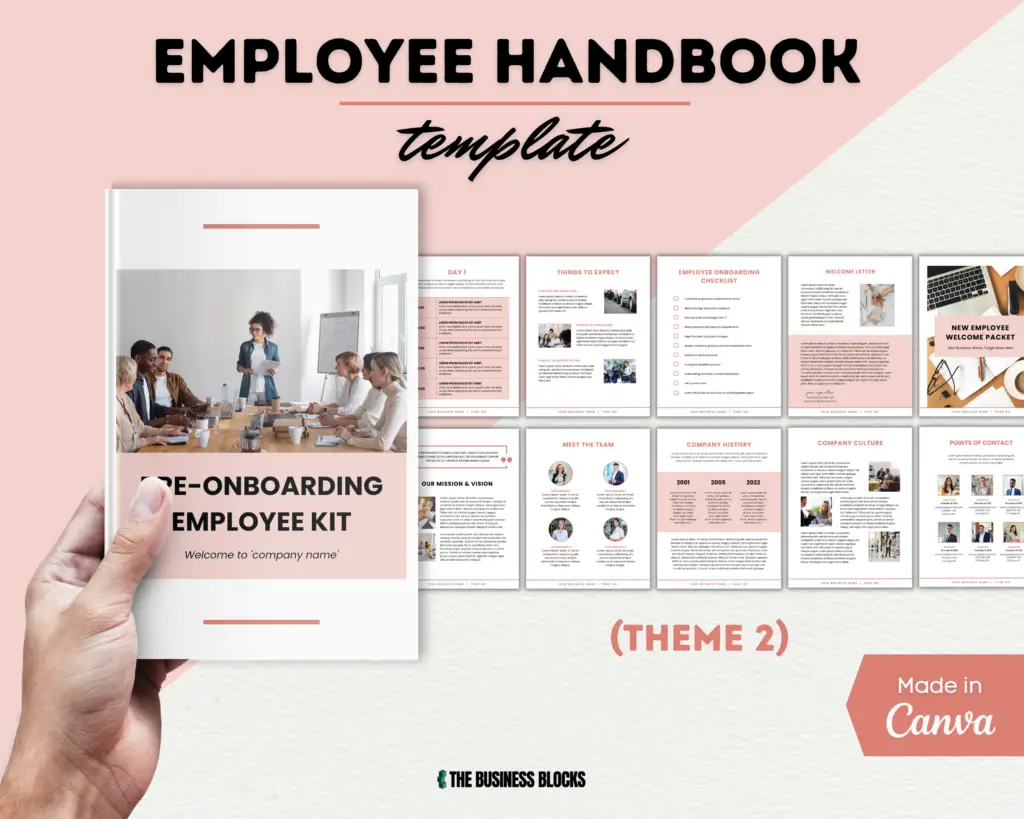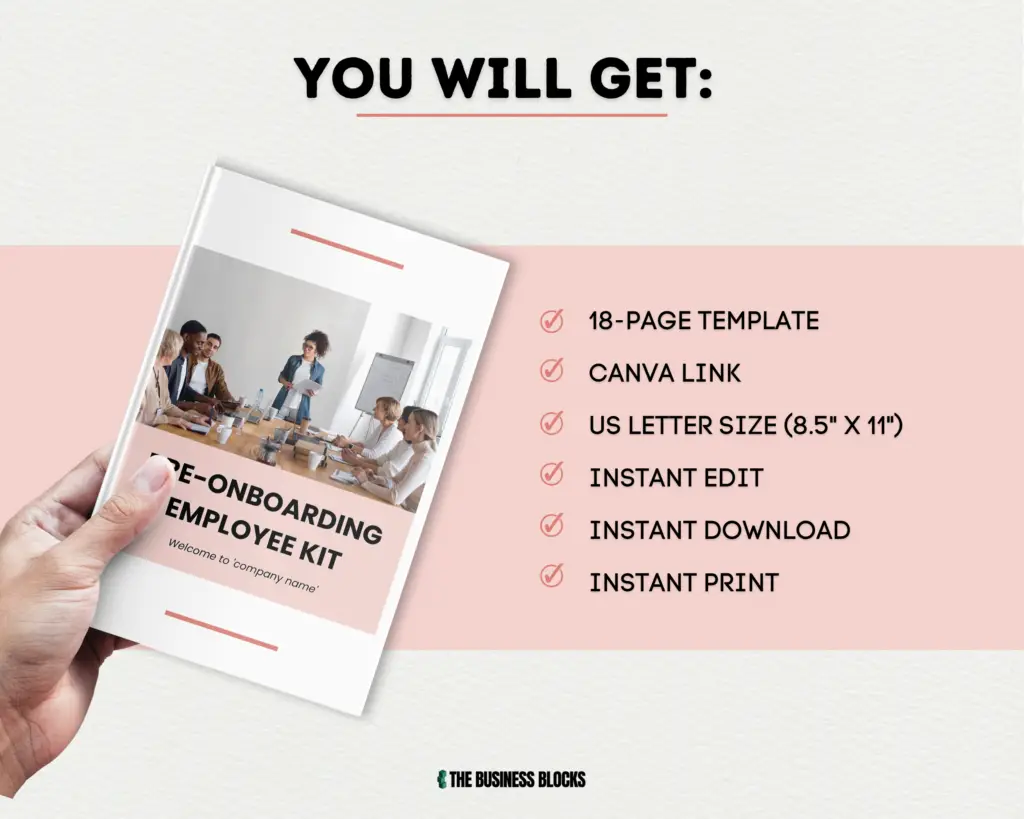What is an Employee Onboarding Handbook?
An Employee Onboarding Handbook is an important HR document resource that provides essential information for new employees during orientation. The handbook typically includes details about the company’s history, culture, policies, benefits, procedures, and expectations for employee conduct.
The handbook is a valuable resource for both the employer and the employee, as it helps ensure that all parties are on the same page regarding company expectations, procedures, and policies. It can also help reduce confusion and questions during onboarding, allowing new employees to focus on their training and job responsibilities.
In addition, the Employee Onboarding Handbook can serve as a reference guide for employees throughout their tenure with the company, providing important information about policies and procedures that may change over time. This can help ensure consistency in applying company policies and procedures and reduce the risk of misunderstandings or non-compliance.
Overall, the Employee Onboarding Handbook is an important HR document resource that helps ensure new employees have the information they need to succeed in their new role and that all parties are aligned on company policies and expectations.
Looking for an Employee Onboarding Handbook template?
Are you looking for an easy-to-follow Employee Onboarding Handbook template that you can easily and instantly edit and customize? This template provides a comprehensive guide for new employees, outlining all the necessary information to help them get off to a great start.
This handbook covers everything from the onboarding process to work expectations and company policies.
With this template, you can be sure that your new employees have all the information they need to make their transition into your company as smooth and successful as possible.
You may quickly modify the template to match your unique demands and specifications because it is fully editable in Canva.


WHAT’S INCLUDED?
- Your Live Canva Document for Editing in US Letter Size (8.5″x11″)
- A PDF Containing Quick Instructions on How to Use & Get Started
PAGE INCLUSIONS:
– Cover page
– First Day
– Things to Expect
– Employee Onboarding Checklist
– Welcome Packet Cover
– Welcome Letter
– Our Mission & Vision
– Meet the Team
– Company History
– Company Culture
– Point of Contact
– Employee Benefits
– Time-off Policy
– Standard of Conduct
– Resources & Tools
– Legal Section
– Acknowledgement Form
– Back page
REQUIREMENTS
- For Editing: Canva Online Version – https://partner.canva.com/c/2347002/619765/10068
- For Printing: Adobe Acrobat Reader or Canva Online Version
OTHER INFORMATION
To alter or modify these templates, some familiarity with Canva is required.
You will not be provided with printed materials or physical products; this is a digital product.
The Business Blocks owns the rights to its designs. You may use the template as often as you like but not share it with anybody outside your business. Please get in touch if you need assistance with repairing or amending.
There are no returns because of the nature of the product, but we’d be happy to work with you to resolve any problems.

All-in-One HR Templates Bundle
With over 50 templates covering various aspects of HR, including recruitment, performance evaluation, employee benefits, and more, this All-in-One HR templates bundle provides everything needed to streamline HR operations and maintain compliance.
Why is Employee Onboarding Handbook important for your business?
The Employee Onboarding Handbook is an important document for businesses for several reasons:
- It sets expectations: The handbook helps to set clear expectations for new employees regarding company policies, procedures, and culture. This can help to ensure that new employees understand what is expected of them and what they can expect from the company.
- It promotes consistency: By providing a consistent source of information for all employees, the handbook can help to ensure that company policies and procedures are applied uniformly and fairly. This can help to reduce misunderstandings and potential conflicts.
- It saves time: Providing new employees with a comprehensive handbook can help to reduce the time and resources required for individual orientation sessions. This can allow new employees to start their jobs more quickly and efficiently.
- It reduces risk: The handbook can serve as a legal document that outlines company policies and procedures, which can be helpful in the event of legal disputes. It can also help to ensure compliance with legal requirements and regulations.
- It enhances company culture: The Employee Onboarding Handbook can help to reinforce company culture and values by providing new employees with a clear understanding of the company’s mission, vision, and values.
Overall, the Employee Onboarding Handbook is an important document for businesses as it helps to set expectations, promote consistency, save time, reduce risk, and enhance company culture. By providing new employees with a comprehensive guide to company policies, procedures, and culture, the handbook can help to ensure a successful onboarding experience and set the foundation for a positive employment relationship.
Wrap Up
In conclusion, the Employee Onboarding Handbook is a valuable HR document for businesses as it provides new employees with essential information and sets clear expectations for their employment. The handbook promotes consistency and saves time by providing a comprehensive guide to company policies and procedures, reducing the need for individual orientation sessions.
It also reduces legal risks by ensuring compliance with legal requirements and regulations and serves as a legal document in disputes. Additionally, the handbook enhances company culture by reinforcing the company’s mission, vision, and values, helping to ensure that new employees are aligned with the company’s goals and objectives.
Overall, the Employee Onboarding Handbook is a critical component of the onboarding process and is an essential resource for both employers and employees, helping to ensure a successful start to the employment relationship.
